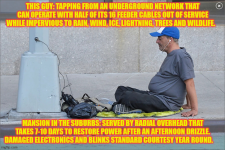Baloney. Would you enter a submerged vault without testing first? Scratch that…ANY vault? Most of the equipment for the City of Charleston, SC for instance is underwater indefinitely. Ok another hint: why do pole lines not self destruct or become major shock hazards when it rains? Because water itself isn’t terribly conductive. It’s a myth, it’s only when it mixes with electrolytes that it’s dangerous.
Plus MV equipment is built to very different standards. If I open a LV starter, transformer, etc., both controls and power circuits are right there in my face mixed together. In the vast majority of MV equipment power and controls are in physically separate areas with internal walls. HV and LV sections of transformers are in different compartments. You won’t find yourself gloving up to test control circuits. Plus many MV systems use high resistance grounding where the touch potential current is below 100 mA…fibrillation is impossible. Plus given a 1000 kVA system at say 480 vs 4160, which has the greater arc flash hazard? The 480 system. Simply put there is neither statistical nor theoretical evidence that MV systems are less safe. It’s a total myth.



